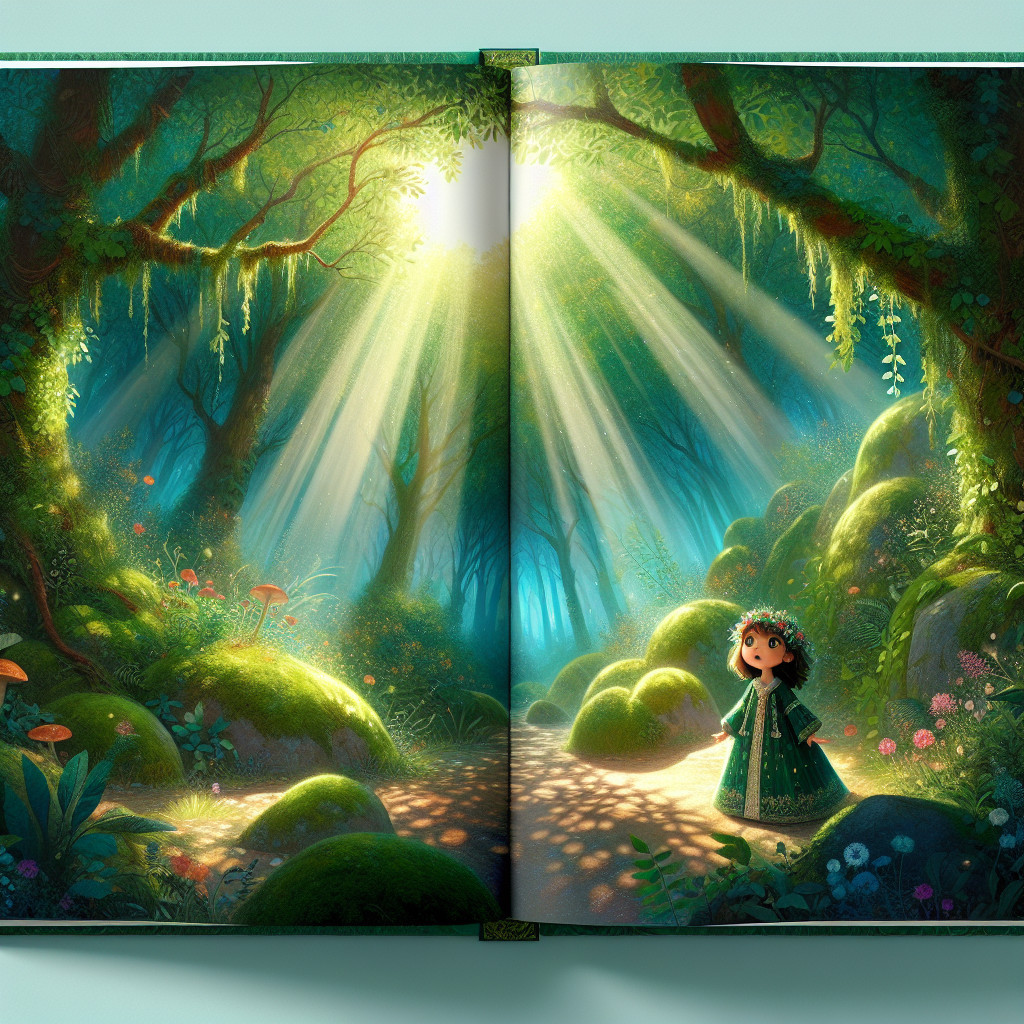Our free Story Idea Generator can come up with unlimited story ideas for you. Or if you prefer to do it yourself then please read on.

Every aspiring children’s book author has been there: the mind buzzing with a hive of ideas, yet struggling to catch and shape these elusive story threads into a narrative captivating enough to ignite young imaginations. Fear not, in this comprehensive guide we bring you an arsenal of story prompts, tips and techniques to tap into your wellspring of creativity and generate remarkable children’s book story ideas.
Writing a children’s book is a unique endeavor that invokes our inner child while challenging us creatively and intellectually. It requires translating complex world ideas into simple, relatable concepts infused with enchanting narration and engaging illustrations. But where does one begin? Do you start with a character or a topic? Or should the focus be on crafting a moral or message for kids? Demystifying these questions forms the crux of our guide “Unleash Imagination: 300+ Children’s Book Story Ideas & Inspiring Prompts”.
We’ll dive deep into children’s book idea prompts, navigated by both broad themes and specific pointers. We will walk along the stepping stones of creativity, from brainstorming techniques to picturising book suggestions; from short story concepts to the architecture of award-winning plots. And in doing so, we’ll explore innovative ways to summon your muse – say hello to ‘prompt to generate story ideas for kids’.
You might wonder what makes an idea worthy of being turned into a children’s book. How do you sift through the diverse idea pool you’ve accumulated and select one (or more) that resonates with a child’s perspective, simmers with potential for conflict and resolution, and tugs at the heartstrings of your adult readers too? Those thoughts may seem like scattered puzzle pieces now, but this guide will slowly help you assemble them into a picturesque, kid-approved narrative.
In our quest for exceptional children’s book story ideas, we invite you to journey along the shores of imagination, explore the forests of fantasy and climb the mountains of morals. We’ll navigate through popular themes, from friendship, family and belonging to courage, kindness and curiosity. And to equip you further in your storytelling adventure.
Through the course of this article, we aspire to be your sturdy lighthouse amidst the vast sea of creativity. If you’re an aspiring author feeling a bit lost or overwhelmed, or a seasoned one seeking fresh inspiration – strap on for a ride as we delve into the enchanting realm of children’s literature.
As we progress, remember that every child is unique and so is every story – there really isn’t one-size-fits-all advice when it comes down to crafting children’s books. Hence, these guidelines and prompts are not strict rules but creative springboards designed to help you soar high on your own unique flight of imagination.
And now, without further ado, let’s embark on our shared journey to find great ideas for your children’s books. Witness as we peel back the layers of creativity, then weave together threads of ingenuity, passion and perseverance to create the vibrant tapestry that forms the heart of every mesmerizing children’s book.
Accumulating and Filtering Children’s Story Ideas
Great children’s books weave a magical charm around kids, capturing their attention and transporting them into fantastical realms. But the first brick in the wall of these intriguing tales often starts with a simple idea: a thought or a concept that strikes a chord and triggers an avalanche of creativity. This is where your journey begins to find great ideas for your children’s books.
Think back to your own childhood. What stories fascinated you? What characters did you feel connected to? Many times, the best story inspirations are hidden in the nooks and crannies of our past. Turn your personal experiences, memories, emotions into meaningful narratives. Remember that well-loved children’s story about a lost puppy? An mischievous alien? Or that enchanted castle? Well, you can come up with your own variations!
Aside from this, don’t ignore the power of real-world observations. Keep an eye on what children around you enjoy doing. Can playing with slime morph into an adventure featuring ‘Slimey The Goo’? Or could ‘The Missing Soccer Ball’ be the mystery that young detective Sally needs to solve? Give wings to your imagination and let it fly across the landscape of everyday life.
Brainstorm Children’s Book Ideas
Mind mapping is another potent tool for generating compelling children’s book story ideas. Start with a basic theme in mind – say, friendship and then expand upon it. Come up with sub-themes like making new friends at school or bonding with animals, then further brainstorm events revolving around each sub-theme – maybe a class project where new friendships bloom, or a lonely child finding companionship in an abandoned kitten.
If you’re more inclined towards teaching through stories, try brainstorming moral lessons or values you’d like to incorporate into your story. From honesty and courage to kindness and empathy, the sky’s the limit. When you’re writing for children, remember that every story is an opportunity for them to learn something new about the world and themselves.

Filtering Story Ideas
By now, you likely have a potpourri of children’s book idea prompts. How do you decide which one makes it into your book? Start by asking yourself: Would this idea excite a child? Is there scope for conflict, growth, and resolution? Does it convey a meaningful message?
Your target audience’s age group plays a crucial role in this decision-making process. A preschooler might enjoy a simple story about farm animals and their antics while middle-grade kids might be more intrigued by a mystery set in their school campus. Understanding what appeals most to different age groups can help you pick the right idea from your stash.
No matter how promising an idea seems, always do a litmus test with sample readers. Get feedback from children around you- after all, they’re the ones who’d be reading these stories! Don’t shy away from revisions – tweaking your ideas based on feedback will only make your work stronger.
In conclusion, accumulating great children’s book story ideas is like planting seeds. Some may flourish into delightful tales while others might need more cultivation. Keep nurturing your imaginative garden with patience, passion and persistence and before long you’ll find yourself amidst an enchanting forest of mesmerizing narratives!
Turning Prompts into Ideas
In the quest for children’s book story ideas, it is often beneficial to set out on a treasure hunt laden with prompts. These stimuli can serve as stepping stones, guiding you from a vague idea towards a concrete, captivating narrative.
Consider prompts somewhat like seeds of creativity, fulfilling the same role as rain does to plants; nourishing your thoughts and encouraging them to blossom. Like the starting point of a connect-the-dots puzzle, a prompt can lead you down trails of innovation and imagination you might not have explored otherwise.
A Trove of Prompts
Whether you’re kicking off your first children’s book or are an experienced author staring at blank pages, the trick is to find prompts that ignite your imaginative spark. To help set fire to your mind’s creative tinder, we offer more than 200 ideas with prompts like ‘101 prompts to write a picture book’ or ‘200 children’s book prompts to inspire you’.
These prompts span across various genres – from whimsical fantasies and humorous tales to educational narratives and rhymed stories. Some suggest characters or events while others provide openings or endings for potential narratives.
Breathing Life into Prompts
Prompts alone do not make stories; they need your writer’s touch – your unique interpretation and elaboration. For instance, consider the prompt: “A grumpy goblin learns about joy.” You may decide the goblin encounters unusual creatures in his gloomy cave who teach him happiness through music. Another author might spin a tale where the goblin finds an abandoned baby laughing uncontrollably at the goblin’s grumpiness, slowly thawing his icy heart!
The key here is exploration. Take each prompt on a test drive, let your thoughts wander with it. Jot down whatever comes to mind – character profiles, potential conflicts, plot twists. Even if an idea doesn’t click immediately, don’t discard it. Like wine, some ideas get better over time.

Combining Prompts
While a single prompt can sprout numerous story concepts, combining prompts can yield even more exotic and robust narratives! Clubbing ‘A magical door opens in the school library’ with ‘An adventurous class hamster’ might brought about an epic saga of a brave hamster who stumbles upon this door and ventures into mystical realms!
Such combinations open up alternate perspectives and weave new dimensions into your story, making it richer and more engaging for your young readers.
Transforming Prompts into Narratives
The final stage of metamorphosing prompts into children’s book stories involves adding layers to your narrative. Start by creating characters that come alive – they should have their individual personalities, quirks, strengths and weaknesses. Next, build your plot around the conflict resolution process which acts as the backbone of your narrative.
Incorporate elements such as dialogues and imagery to make the story immersive. Maintain a simple yet impactful language style – use words that kids can understand but also introduce them to new terms gradually.
In conclusion, children’s book story ideas are akin to uncut diamonds – they need just the right amount of pressure and precision cut from prompts to reveal their true brilliance. So go on now, dive into our treasure chest of prompts; let them be the potter’s wheel shaping the clay of your creativity into enchanting tales your readers would cherish forever!
Creating Award-Winning Plots
A great story idea is akin to a seed, but to grow it into the captivating tree of a children’s book, you must build an award-winning plot. A well-constructed plot serves as the scaffolding upon which your story will rise, providing structure and direction. So, how can one transform ‘how to create an award-winning plot for a children’s book’ from mere theory into riveting practice? Let’s delve in.
Understanding Plot Structures
At its core, every plot comprises certain fundamental elements: exposition (introduction), rising action (building up of conflict or tension), climax (peak point of conflict or tension), falling action (resolution) and denouement (conclusion). Mastery over these crucial elements allows you to weave together disparate threads of thought into a cohesive narrative.
Exposition
Your story’s introduction should be compelling enough to draw a child into your narrative universe. It’s where you introduce your main characters, set the stage for the upcoming adventure and hint at potential conflicts. For example, consider Harry Potter’s introduction in J.K.Rowling’s classic – we know immediately that he is an orphan living with his nasty relatives and something magical lurks around him!
Rising Action and Climax
The rising action provides momentum to your plot by adding complexity and dimensions to the conflict. Children are naturally drawn towards stories that promise excitement, adventure or mystery; hence aim for a thrilling escalation leading to an intriguing climax. The climax is where we reach peak intensity – this could be when Cinderella loses her glass slipper at the ball or when Little Red Riding Hood faces the Big Bad Wolf!
Falling Action and Denouement
Following the high of the climax, your plot should slowly untangle the knots of conflict through the falling action. Here is where you tie up loose ends, providing satisfactory resolutions to any sub-plots or secondary conflicts. Finally, the denouement offers a fitting closure. This is your chance to leave readers with a lingering afterthought, a moral lesson or simply a sense of contentment.
Considering Audience Age
An integral aspect while plotting your story is considering your target age group’s comprehension level and thematic preferences. For instance, younger children might appreciate simple cause-effect relationships and more visual cues, while older ones can handle complex multi-layered plots and themes such as friendship complexities or dealing with school pressures.
Injecting Unpredictability
A clever trick to ensure your plot stays memorable is by incorporating surprise elements – unexpected plot twists, secret revelations or unpredictable character decisions can keep young readers hooked till the last page!
In conclusion, creating an award-winning plot involves balancing multiple elements – well-paced action, engaging conflict and satisfying resolution, all sewn together with an underlying thread of consistency. Your plot should be exciting yet plausible, complex yet comprehensible; being able to strike this balance could very well transform ‘how to create an award-winning plot for a children’s book’ from mere theory into thrilling reality!

Generating Picture Book Concepts & Short Story Ideas
An image says a thousand words, and in the world of children’s literature, this adage stands even more resolute. A well-crafted picture book is like a ticket to an enchanting journey through visuals, where every illustration adds another layer of magic to the narrative—be it a whimsical fairyland or a bustling town full of quirky animal characters.
Picturising Your Narrative
The first step towards creating vibrant picture book ideas is visualizing your narrative. Imagine how each scene would look if it were painted on a canvas. Who are the characters involved? What actions are they performing? Is there a striking element that can induce intrigue or laughter? The intent is to make children turn page after page with bated breath wondering what visual spectacle awaits them next!
Pictures as Storytellers
In picture books, illustrations don’t just complement the text; they tell half the story! They are more than mere decorations, they serve as active narrators relaying vital plot points, character emotions and locations – things that might not be explicitly mentioned in the text.
For instance, your book might follow Sammy the snail’s adventures. The text tells us about Sammy’s fun day at school, but only through pictures do we discover that Sammy’s school is inside a mushroom and his classmates include insects like ladybugs and spiders!
Creating Mood Through Illustrations
Illustrations have an immense potential in setting up mood and atmosphere of your story. Use dark, monochromatic shades for suspenseful scenes and vibrant hues for cheerful ones. Want to portray the vast expanse of Sammy’s garden home? Go for wide-angle landscape shots. A close-up of Sammy’s scared face as he faces a predatory bird can heighten the sense of danger.
Short Story Ideas for Children’s Books
Short stories are like delicious snacks for young minds – quick to consume but packed with nutrition in its compact form! They are perfect for kids who enjoy varied experiences, love exploring different worlds and characters or simply have a shorter attention span. Crafting short story ideas for children’s books, though challenging, is a rewarding endeavor.
Simplicity is Key
The key to a great short story lies in simplicity. While your idea needs to be exciting, remember that brevity restricts you from incorporating too many subplots or characters. Choose a single conflict and focus on resolving it over the course of the story.
For instance, your main character could be Buzzy the bee who loves exploring. One day she ventures out too far from her hive and gets lost – leaving you with an interesting premise to explore!
Crafting Endings that Stick
In conclusion, while crafting picture book concepts and short story ideas may seem daunting initially, it is essentially about letting your creativity run wild. The goal is to spark joy, foster curiosity, and encourage imaginative thinking in children. With patience and practice, you’ll slowly master the art of creating captivating visuals and compelling short narratives that will charm and entertain your young readers!
Writing and Illustrating Your Book Idea
Congratulations! You’ve reached the final step of your journey to bring your children’s book story ideas to life. It’s time to put pen to paper, or fingers to keyboard, and turn your cherished concept into a captivating children’s book.
Start with a Solid Foundation
A well-crafted story begins with a solid foundation – an outline or a rough plan that guides you throughout the writing process. This roadmap can help you stay focused on your main plot, but also allows for creative detours along the way.
Consider creating an outline that includes key plot points, character development, and any important themes or lessons you want to convey. Don’t worry about making it perfect from the start; you can always revise and refine your outline as you go.
Choosing the Right Writing Style
The writing style of a children’s book should be engaging, accessible, and age-appropriate. Keep in mind the target age group as you craft your sentences and choose vocabulary that they can easily understand. However, don’t shy away from introducing new words and concepts to expand their knowledge.
If you’re unsure about the reading level of your book, read it aloud to children within your target age range and observe their reactions. Pay attention to any parts where they seem confused or disengaged, as this will help you identify areas that need improvement.
Pacing and Flow are Key
The pacing of your story is crucial in maintaining the interest and attention of young readers. A slow-paced story may cause them to lose interest, while a fast-paced story can feel overwhelming or confusing.
Consider incorporating pauses or breaks between action-packed scenes to allow kids to catch their breath and process what’s happening. On the other hand, moments of suspense or excitement can be heightened by quickening the pace through shorter sentences or paragraphs.
Breathe Life into Your Characters
Your characters play a central role in capturing young imaginations. Give them distinct personalities, quirks, and emotions that children can relate to. Make them feel real and relatable by incorporating their desires, fears, and dreams into your narrative.
Additionally, consider creating diverse characters that reflect different backgrounds, cultures, abilities, and experiences. Representation matters – seeing themselves mirrored in the pages of a book helps children develop empathy and understanding for others.
Illustrating Your Book
In addition to writing compelling text, illustrations add another layer of magic to your children’s book. If you’re an artist, this is your chance to showcase your skills and bring your characters to life visually. If not, consider collaborating with an illustrator who shares your vision for the book.
Collaborating with an illustrator allows you both to contribute your unique talents and perspectives to create a cohesive visual narrative. Provide detailed descriptions of your characters’ appearances and any specific scenes you envision. Remember that illustrations should enhance the story without overpowering it.
Create a Visual Dance with Text
Ensure that there is harmony between the text and illustrations in each spread of your book. Allow the images and words to work together seamlessly – sometimes conveying information independently while at other times intertwining beautifully.
Determine how much text each page needs based on the intensity of the scene or illustration accompanying it. Balancing text with visuals is vital in maintaining engagement as too much text might overwhelm younger readers while too few words could leave older readers seeking more substance.
Crafting Memorable Endings
The ending is where all loose ends come together – where conflicts find resolution or new possibilities arise. For picture books targeted towards younger audiences, endings often offer closure with gentle messages of hope or happiness.
For older readers who enjoy chapter books or middle-grade novels, consider endings that leave room for interpretation or reflection. Allow space for readers’ imagination to thrive beyond what is explicitly written on the page.
Edit, Revise, Repeat
Once you’ve completed your first draft—congratulations! But remember, crafting an exceptional children’s book takes multiple rounds of editing and revision. Polish your manuscript by reviewing it for clarity, coherence, pacing issues/plot holes along with grammatical errors — ensuring every word shines!
Solicit feedback from trusted beta-readers such as fellow writers or educators familiar with children’s literature. Consider joining critique groups where members provide constructive criticism on each other’s work—they can be invaluable in helping you refine your storytelling skills further!
You’re Ready!
You’ve accomplished so much already on this exciting journey towards bringing enchanting stories into young hearts! Now take these tips, prompts,
and techniques as stepping stones towards manifesting extraordinary children’s book story ideas.